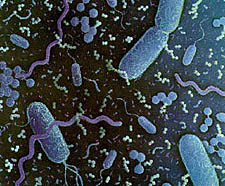The rainforest is one of many biomes that is being destroyed at an unbelievable rate. Below are some facts borrowed from www.ran.org/info_center/factsheets/04b.html...
Photo from - www.solcomhouse.com
Global Rates of Rainforest Destruction
2.4 acres per second or two football fields per second
149 acres per minute
214,000 acres per day (an area larger than New York City)
78 million acres per year (an area larger than Poland)
Species Extinction
137 species are driven into extinction every day
50,000 species each year
Brazil Rainforest Destruction
50,000 square kilometers being destroyed each year
(equivalent to 10.3 million football field size areas of forest)
IMPORTANT - While you were reading the above statistics, approximately 149 acres of rainforest were destroyed. Within the next hour approximately 6 species will become extinct.
Ecosystems are destroyed for a variety of reasons. Many people feel these activities outweigh the environmental long-term effects. These include commercial logging, clearing for agriculture, ranching, fuel production, housing, road building, timber harvesting, mineral mining and oil extraction. The problem with this is that these ecosystems contain an estimated half of the world's plant and animal specials and they contribute to regional and global climate.
However, the consequences far outweigh the benefits as far as enviromentalists are concerned. The short-term effects may be appealing but we are now noticing the massive repercussions of the long-term effects. The forested areas that once had fertile soil are now not at all fertile. This is because the fragile nutrient cycling system between the plants, animals and decomposers (insects, worms and microbes) has been essentially destroyed. Also, with no vegetation, the rate of erosion will greatly increase which causes all of the fertile soil to be washed away with the rain - which is over 300 cm. per year. When the soil erodes, it runs into nearby lakes and streams causing water pollution and the increase in the water levels can also cause flooding in low lying areas. This destroys these ecosystems as well. Also, fewer trees on the planet is bad for global warming. Trees remove carbon dioxide from the atmosphere. With less trees, there will be an increase in carbon dioxide and as a result an increase in global temperatures. These are just a few of the many consequences and we have not even discussed the loss of biodiversity.
Photo from -http://www.kula.net/~lnebres/home/avocados1.html
Deforestation = cutting down trees. It should be that simple but it is NOT! Avocado trees grow in the tropical rainforests and are involved in a very complex food chain. When we cut down this tree, not only did we lose the avocado tree but we potentially lost the animals that feed on it and also the plants and microorganisms that live on the tree. In the rainforest, there are many microecosystems within the larger ecosystem and the interactions within and between these are completely intertwined.
Kinkajou image - http://www.crrobs.org/community/
news_prof.shtml |
Red-eyed tree frog image
- http://www.sunysccc.edu/library/biology.html
|
Jaguar image - http://www.belizeit.com/zoo.htm
|
The animals seen here are involved in the same food chain as the avocado tree. The red-eyed tree frog is a insectivore that feeds on beetles that feed on the tree. The kinkajou, an omnivore, feeds on the beetle as well as the tree itself. The jaguar is a top-level consumer in a rainforest. It feeds on the kinkajou as well as a plethora of other birds and mammals in the rainforest ecosystem. Again, these organisms are very closely intertwined in their food web and when one is disturbed or worse yet forced into extinction, the others are affected to some degree. They may even go extinct themselves.

Photo from - http://www.astrobio.net/news/print.php?sid=163
Bacteria are extremely important to the recycling of nutrients in the rainforest. They break down the waste organic matter found on the forest floor. Click here to learn a little more about the interactions of microbes in soil and the symbiosis that occurs between bacteria and fungi - You will be quizzed on this later. As a result of microbial actions, the nutrients from the organic matter do not reach the soil and therefore, the soil is rather poor. However, the problem escalates when trees are removed. The soil will then dry out and the organic waste deteriorates. The soil microbes then die out and the soil is "dead" and erodes away. Click here for more information on microbes and the effect of deforestation - Don't forget - The quiz is later!!!
There are many other ecosystems being destroyed at an incredible rate - To learn more information about these fragile areas of our planet, visit the following weblinks. Just click on the link to take you there.
Coral Reefs
http://www-ocean.tamu.edu/education/oceanworld/students/coral/coral5.htm
http://www.conservation.org/xp/news/press_releases/2002/021402.xm
Wetlands
http://www.bsu.edu/ourlandourlit/Environment/Issues/Wetland_destruction.html
http://www.ohiodnr.com/wetlands/default.htm
Freshwater Ecosystems
http://eces.org/ec/ecosystems/freshwater.shtml
Intertidal Ecosystems
http://www.biology.ucsd.edu/labs/roy/CBRISC
**Icon images from www.clipart.com**
**Button Icons from www.grsites.com**